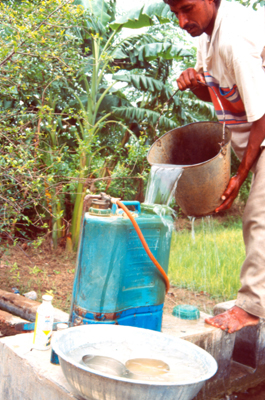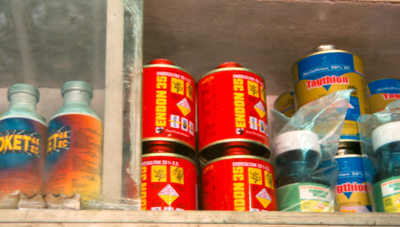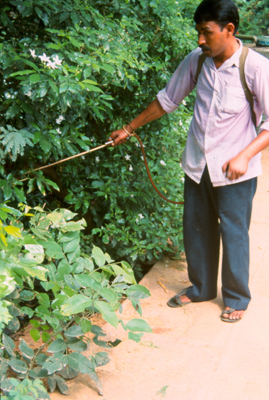| You are at Toxics Alert > Report > How Safe Is The Food You Eat? | |||
 |
 |
||
|
Subscribe || Tell a Friend || Print View | ||
| Home | Editorial | Feature | Interview | News | Policy | Updates | Reports / International News | Partner | |||
|
How Safe Is The Food You Eat?Source: Toxics Link, Date: , 2009 The Ministry of Food Processing
Industries, Government of India, has declared the year 2008-09 as ‘Food
Safety and Quality Year’. The Ministry of Food Processing
Industries, Government of India, has declared the year 2008-09 as ‘Food
Safety and Quality Year’. Previously in 2006 the Food Safety and Standards Act 2006 was introduced to give more importance to the safety standards. "Food safety" implies absence or acceptable and safe levels of contaminants, adulterants, naturally occurring toxins or any other substance that may make food injurious to health on an acute or chronic basis. So how safe is the food that we eat everyday? We are what we eat. Our nutritional status, health, physical and mental faculties depend on the food we eat and how we eat it. Food contamination can take place at various stages of the food chain from farm to table. Apart from chemical contamination of food from various sources such as industries, vehicles, pesticides and fertilizers, pollution resulting from growing of vegetables in degraded environmental conditions in peri-urban zones also affect food safety. This is coupled with further pollution from vehicles and industries during marketing. The common sources include presence of heavy metals, pesticides, preservatives, colouring agents and other additives and adulterants in food. One of the chief miscreants is the pesticide that is widely used to bring about food safety in way of minimizing the pest attacks on crops.  Pesticide : a Lurking Menace Pesticide : a Lurking MenacePesticides are a group of chemicals designed to control weeds, diseases, insects, fungi or other pests on crops, landscape or animals. The most commonly used pesticides are insecticides (to control insects), fungicides (to control fungi) and herbicides (to control weeds). The world has seen enormous rise of pesticides uses for agricultural purposes to enhance the food production and feed the population of the world. India uses about 30,000 tons of pesticides a year, more than 60% of it on food crops. Use of excessive pesticides contaminates soil, water and finally enters the food chain and contaminates the food produced. About 20% of Indian food products contains pesticide residues above the tolerance level compared to only 2% globally. No detectable residues are found in only 49% Indian food products compared to 80% globally. Pesticides are widely used throughout the world in agriculture to protect crops but they pose significant health problems besides commonly contaminating soil, air and water. The high-risk groups exposed to pesticides include the production workers, formulators, sprayers, mixers, loaders and agricultural farm workers. The United Nations Environment Program estimates accidental pesticide poisoning causing 20,000 deaths and 1 million cases of illness per year worldwide. Pesticides have been implicated in human studies with leukemia, lymphoma, aplastic anemia, soft tissue sarcoma and cancers of the breast, brain, prostate, testis and ovaries. The International Agency for Research on Cancer has found "sufficient" evidence of carcinogenic potentiality in most of the pesticides beyond the threshold limit. Legal Provisions There are legal provisions to combat this menace. Section 21: (1) of the Food Safety and Standard Act-2006 states that no article of food shall contain insecticides or pesticides residues, veterinary drugs residues, antibiotic residues, solvent residues, pharmacological active substances and micro-biological counts in excess of such tolerance limits as may be specified by regulations. (2) No insecticide shall be used directly on article of food except fumigants registered and approved under the Insecticides Act, 1968. Explanation. -For the purposes of this section, - (1) "Pesticide residue" means any specified substance in food resulting from the use of a pesticide and includes any derivatives of a pesticide, such as conversion products, metabolites, reaction products and impurities considered to be of toxicological significance and also includes such residues coming into food from environment; Similarly Rule - 65 (Para-XIV) of the Prevention of the Food Adulteration rule –1955 has the provision on the restrictive use of pesticides (insecticides) where as Rule 65 (2) has also stated that the insecticides content shall not exceed the tolerance limit prescribed for the food items mentioned below.  Acceptable Daily Intake and Maximum Residue Limit Acceptable Daily Intake and Maximum Residue LimitThe prescribed Acceptable Daily Intake (ADI) and Maximum Residue Limit (MRL) for India is being determined based on the recommendation of the Codex Committee on Pesticides Residues (CCPR) a subsidiary body of the Codex Alimentarius Commission. Acceptable Daily Intake or ADI is a measure of the amount of a specific substance (usually food adititive or pesticide) in food that can be ingested (orally) over a lifetime without an appreciable health risk. Without appreciable risk" refers to the practical certainty that injury will not result, even after a lifetime of experience. ADIs are expressed by body mass, usually in milligrams (of the substance) per kilograms of body mass per day. The concept of ADI was first introduced in 1961 by the Coucil of Europe and later the Joint Expert Commiitee on Food Additives (JECFA), a commiitee maintined by two United Nations bodies: the Food and Agricultural Organisations and WHO. The ADI is a practical approach in determining the safety of food. It also serves to ensure that the actual human intake of a substance is well below toxic levels. The ADI is generally being determined based on a scientific review of all available toxicological data on a specific additive D based on both observations in humans and tests in animals. Laboratory tests in animals determine the maximum dietary level of the additive that is without demonstrable toxic effects, i.e., the "No Observable Effect Level" (NOEL). This level is then extrapolated to man by dividing the no-effect level by a large factor, often 100. This results in a substantially lower level for man, and thus a large margin of safety Maximum Residue Limits or MRL for pesticides are established in most countries to safeguard consumer health and to promote Good Agricultural Practice (GAP) in the use of insecticides, fungicides, herbicides and other agricultural compounds. MRL is the maximum concentration of a substance, expressed in milligrams per kilogram (parts per million, ppm) or in micrograms per kilogram (parts per billion, ppb) that is legally permitted in a food commodity. An MRL is typically applied to a veterinary drug or a pesticide and is established for particular food commodities such that potential consumer exposure to residues is judged to be toxicologically acceptable. The MRL set for a substance may differ for different food commodities, reflecting the contribution of the particular food to a "standard" diet. Normal intake of food containing residue of a substance at its MRL is not expected to result in the ADI being exceeded. Since residues of pesticides and drugs may be broken down in tissue into various metabolites, MRLs are expressed either in terms of the amount of the parent compound remaining, or a metabolite that is representative of the residue of toxicological concern in the food. Estimates are usually made by comparing the acceptable daily intake (ADI) with a calculation of the total intake of the residue based on the MRLs and food intake data of these commodities for which MRLs have been established. Codex Committee on Pesticides Residue Committee of the Codex Alimentarius Commission develops and maintains acceptable pesticide Codex maximum residue limits (MRLs) for food commodities in international trade. However, neither the USA nor the EU approves Codex MRL. Instead, they independently set their own standards. But India is accepting MRL standard determined by Codex. Food Safety and Standard Act-2006 The Food Safety and Standard Act –2006, is an important initiative and development to safe guard food safety and health of the consumer at the same time giving due importance to safety standards in India. The objective of the law is to consolidate eight laws governing the food sector and to establish the Food Safety and Standards Authority (FSSA) to regulate the sector. Relevant provisions of the act include: 1. The act has the features to achieve appropriate levels of protection of human life and health and protection of consumers’ interests including fair practices in all kinds of food; 2. Carry out risk management based on risk assessment; also to adopt risk management measures necessary to ensure appropriate levels of health protection; 3. Risk assessment is to be based on the available toxicological evaluation (e.g. JECFA) and extensive open and transparent discussion with all stakeholders, and the underlying principle is to ensure protection of consumers by preventing fraudulent, deceptive or unfair trade practices. 4. In case of suspected risks of the public consuming contaminated food, the FSSA will take appropriate steps to inform the general public of the risk to health; The consumer Protection Act, 1986, provides for the better protection of consumers. Unlike existing laws, which are punitive or preventive in nature, the provisions of this Act are compensatory in nature. The act is intended to provide simple, speedy and inexpensive redressal to the consumers' grievances, award relief and appropriately compensate the consumer. The act has been amended in 1993 both to extend its coverage and scope and to enhance the powers of the redressal machinery. The Food Safety Act-2006 explicitly deals with the overall concerns related to food safety in India. The act envisages three-tier quasi-judicial consumer dispute redressal machinery at the national, state and district level. These agencies are popularly known as consumer forums or consumer courts. The Consumer Protection Act, which has been defined as “the Magna Carta of Consumers”, spells out six consumer rights: Right to Safety, Right to Information, Right to Choice, Right to Representation, Right to Redress, and Right to Consumer Education. Still, the present scenario is not very encouraging. Unfortunately the consumer courts have become replica of legal courts, as the procedure is no longer simple and quick. The consumer redressal process is relatively cumbersome and more expensive and time- consuming than desired. The process involves engaging a professional personnel for filing the case and attending the court proceeding and certain other formalities like producing the bill, warranty cards etc. These procedures need to be made simpler and quicker for making the process more meaningful and realistic. For more in-depth study please refer to link: http://toxicslink.org/pub-view.php?pubnum=216 |
•
Home •
FEATURE •
INTERVIEW •
NEWS •
POLICY •
UPDATES •
REPORTS / INTERNATIONAL NEWS •